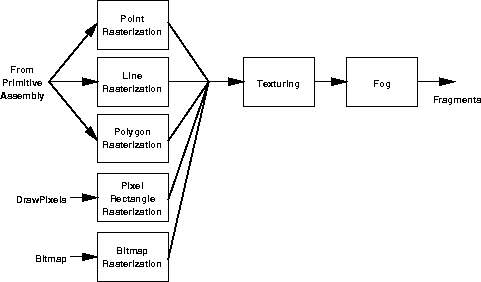
Figure 3.1: Rasterization.
Rasterization is the process by which a primitive is converted to a two-dimensional image. Each point of this image contains such information as color and depth. Thus, rasterizing a primitive consists of two parts. The first is to determine which squares of an integer grid in window coordinates are occupied by the primitive. The second is assigning a color and a depth value to each such square. The results of this process are passed on to the next stage of the GL (per-fragment operations), which uses the information to update the appropriate locations in the framebuffer. Figure 3.1 diagrams the rasterization process.
A grid square along with its parameters of assigned color,
z (depth),
and texture coordinates
is called a fragment;
the parameters are collectively dubbed the fragment's associated data.
A fragment is located by its lower-left corner,
which lies on integer grid coordinates.
Rasterization operations also refer to a fragment's center,
which is offset by  from its lower-left corner
(and so lies on half-integer coordinates).
from its lower-left corner
(and so lies on half-integer coordinates).
Grid squares need not actually be square in the GL. Rasterization rules are not affected by the actual aspect ratio of the grid squares. Display of non-square grids, however, will cause rasterized points and line segments to appear fatter in one direction than the other. We assume that fragments are square, since it simplifies antialiasing and texturing.
Several factors affect rasterization. Lines and polygons may be stippled. Points may be given differing diameters and line segments differing widths. A point, line segment, or polygon may be antialiased.